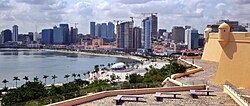Tourism in Angola

The tourism industry in Angola is based on the country's natural environment, including its rivers, waterfalls and coastline.[1] Angola's tourism industry is relatively new, as much of the country was ravaged during the post-colonial civil war which ended in 2002.
Visitor attractions
Cameia National Park
Cameia National Park is a visitor attraction in Angola. It is a national park in the Moxico province of Angola, located at about 1100 m above sea level. It shares its name with the nearby municipality of Cameia. The Cameia–Luacano road forms the northern boundary of the park with the Chifumage River forming the southern portion of the eastern boundary and the Lumege and Luena rivers the south-western boundary. Much of the park consists of seasonally inundated plains that form part of the Zambezi river basin, with the northern half of the park draining into the Chifumage river. There are also extensive miombo woodlands, similar to those in the Zambezi basin of western Zambia. The park is a sample of nature not occurring elsewhere in Angola. Two lakes, Lago Cameia and Lago Dilolo (the largest lake in Angola) lie outside the park boundaries and both have extensive reedbeds and grassy swamps that are rich in aquatic birds.[2]
Cangandala National Park
Cangandala National Park is another visitor attraction in Angola. It is the smallest National Park in the country and is situated in the Malanje province. It is situated between the Cuije river and 2 unnamed territories of the Cuanza River, with the towns of Culamagia and Techongolola on the edges of the park. The park was created in 1963 while Angola was still under Portuguese colony.[3]
Iona National Park
Iona National Park, located in Namibe Province, is another popular tourist destination. It is about 200 kilometres (120 miles) from the city of Moçâmedes and, at 15,200 square kilometres (5,850 square miles), the largest in the country. Before the Angolan Civil War, Iona was an "animal paradise, rich in big game". However, as is true for most Angolan national parks, illegal poaching and the destruction of infrastructure have caused considerable damage to the once rich park. The park is also known for unique flora and outstanding rock formations.[4][5]
Mupa National Park
Mupa National Park in the southwestern Cunene province was proclaimed a National Park on 26 December 1964 while the country was still a Portuguese colony. The park is significant for its expected wide (though generally unstudied) avifauna. Many Angolans reside within the park, which, along with nomadic pastoralists and mineral prospecting threatens to destroy the park's birdlife. According to one article, "Even though the park was initially proclaimed to protect the giraffe sub-species, Giraffa camelopardalis angolensis, by 1974 none were left because the morphology of the White Giraffe leaves it particularly vulnerable to landmines left over from Angola's civil war compared to other giraffe sub-species. Other mammals which occurred, include lion, leopard, wild dog and spotted hyena".[6]
Coastline
Angola borders the Atlantic ocean and has 1,650 km of coastline.[7]
Visitor statistics

Most visitors arriving to Angola for tourism purpose were nationals from the following countries:[8][9]
| Country/Territory | 2015 | 2014 |
|---|---|---|
 Portugal Portugal | 82,629 | 219,258 |
 South Africa South Africa | 49,424 | 56,852 |
 China China | 76,016 | 49,965 |
 Brazil Brazil | 70,184 | 44,001 |
 Namibia Namibia | 61,505 | 25,079 |
 France France | 20,097 | 18,806 |
 United Kingdom United Kingdom | 14,267 | 18,363 |
 DR Congo DR Congo | 13,824 | 692 |
 Congo Congo | 11,432 | 613 |
 India India | 9,170 | 6,464 |
 Italy Italy | 9,150 | 17,274 |
| Total | 592,495 | 594,998 |
See also
References
- ^ Virtual Angola - Tourism - Why Angola? Archived 2008-03-31 at the Wayback Machine
- ^ "BirdLife Data Zone". www.birdlife.org. Retrieved 2017-07-21.
- ^ "BirdLife Data Zone". www.birdlife.org. Retrieved 2017-07-21.
- ^ "Iona National Park travel guide". www.world66.com. Retrieved 2017-07-21.
- ^ "International Spotlight: Angola". www.washingtonpost.com. Retrieved 2017-07-21.
- ^ "BirdLife Data Zone". www.birdlife.org. Retrieved 2017-07-21.
- ^ The Embassy of the Republic of Angola Archived 2008-05-09 at the Wayback Machine
- ^ "Anuário de Estatística do Turismo 2014". Archived from the original on 2016-11-26. Retrieved 2016-12-10.
- ^ "Anuário de Estatística do Turismo 2015". Archived from the original on 2017-06-13. Retrieved 2017-10-15.
External links
- Tourism in Angola | Africa Tourism Web Portal
- Ministry of Hotels and Tourism (in Portuguese)
- v
- t
- e
- Banking
- Banco Nacional de Angola
- Banco Angolano de Investimentos
- Banco Angolano de Negócios e Comércio
- Banco BAI Microfinanças
- Banco BIC
- Banco Caixa Geral Totta de Angola
- Banco Comercial Angolano
- Banco de Comércio e Indústria
- Banco Comercial do Huambo
- Banco de Comércio e Indústria
- Banco de Desenvolvimento de Angola
- Banco Económico (Angola)
- Banco de Fomento Angola
- Banco de Investimento Rural
- Banco Kwanza Invest
- Banco Millenium Angola
- Banco de Negócios Internacional
- Banco Privado Atlântico
- Banco Valor
- Banco de Poupança e Crédito
- Banco Regional do Keve
- Banco Sol
- Banco VTB África
- Finibanco Angola
- Standard Bank
- Standard Chartered
- Airports
- Communications
- Companies
- History of trade
- Trade unions
- Transportation
- Agriculture
- Coffee
- Energy
- Fishing
- Mining
- Petroleum
- Tourism













